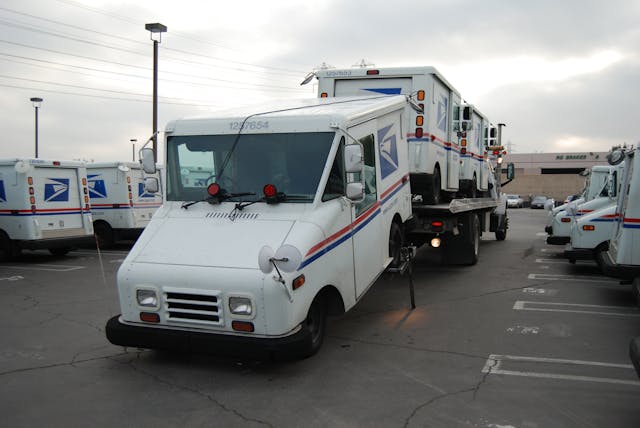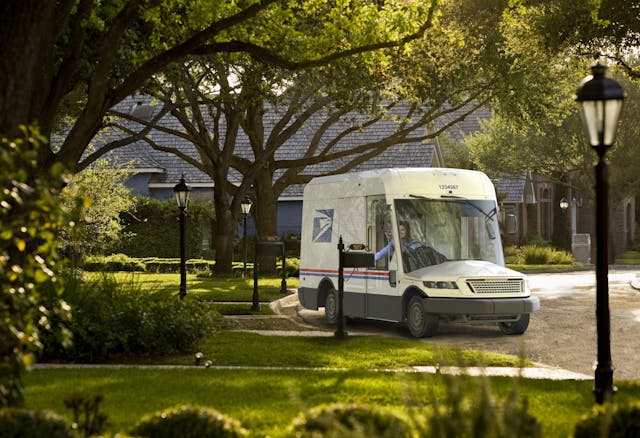Media | Articles
USPS relents: 75 percent of new fleet will be electric

United States Postal Service Postmaster General Louis DeJoy had a problem. The 220,000 Grumman-built Long Life Vehicles, or LLVs, badly needed replacement as the Postal Service’s main delivery truck. The post office gave a 10-year contract to Oshkosh, the Wisconsin company, to build the replacement—the Next Generation Delivery Vehicle, or NGDV, nicknamed “the duckbill platypus” due to its long, flat nose. The vehicles started showing up this year.
Oshkosh can build the trucks either with gas engines or electric powertrains. General DeJoy, looking at his budget, decided to buy mostly gasoline-powered trucks, because they were cheaper and familiar to service. Early fleet ratios said that only 10 percent of the trucks would be electric, the rest gas.

Environmentalists, President Joe Biden being one of them, were aghast. Shouldn’t the federal government lead the way to electrification? Some of those environmental groups sued, as did 16 states, and the EPA complained loudly.
It didn’t help matters that the gasoline-powered Oshkosh NGDV, powered by a 3.5-liter V-6, only delivers 8.6 mpg when the air conditioner is running. The existing Grumman LLV, which doesn’t even have AC, gets only 8.6 mpg too, according to the Postal Service.
So, under pressure, General DeJoy relented. As of December 2022, the Postal Service is increasing its initial order of NGDV duckbills to 60,000, of which 45,000 will be EVs by 2028. The targeted minimum ratio of EVs to gas-burning vehicles in the replacement fleet now stands at 75 percent. All vehicles ordered by the agency after 2026 are expected to be EVs.
Marketplace
Buy and sell classics with confidence

The Postal Service also expects to purchase an additional 21,000 battery-electric delivery vehicles through 2028, representing a mix of commercial-off-the-shelf (COTS) products. Acquisitions delivered in 2026 through 2028 expected to be 100 percent electric. Translation: Oshkosh can’t build enough duckbills, so they’ll buy mostly existing electric vehicles to round out the fleet.
The USPS made it clear that they have a preference for domestic-built vehicles, so we’ll see how quickly some of the manufacturers of EVs can come up with a right-hand-drive variation. Our money’s on the Chevrolet Bolt. It delivers pizza for Domino’s, so it can certainly deliver mail.
On top of all that, “Feasibility of achieving 100 percent electrification for the overall Postal Service delivery vehicle fleet will continue to be explored.”
All this costs money, of course: Total investment is expected to reach $9.6 billion, including $3 billion from Inflation Reduction Act funds. That $3 billion was earmarked by Biden to go towards electrification, so he’s getting his way with this new breakdown of mail delivery product. Of course, that will have to pay for charging stations for the new electric truck, which may or may not be covered in that $9.6 billion.

Said Postmaster General DeJoy: “We have a statutory requirement to deliver mail and packages to 163 million addresses six days per week and to cover our costs in doing so—that is our mission. As I have said in the past, if we can achieve those objectives in a more environmentally responsible way, we will do so.”
Apparently, the President convinced him they can.
Check out the Hagerty Media homepage so you don’t miss a single story, or better yet, bookmark it.













Nice to see a lot less of the usual EV bashing here today. 🙂
Also, CleanTechnica is talking about the switch today too:
US Postal Service Caves On Electric Vehicles, But What About The Trucks?
https://cleantechnica.com/2022/12/22/us-postal-service-caves-on-electric-vehicles-but-what-about-the-trucks
Logical move.
Keep in mind that there are thousands of rural routes where EV ranges are not going to work. Oshkosh Defense/USPS had the right ratio until those useless political idiots started spouting liberal drivel. Let the experts make those decisions. By the way, locating the Oshkosh plant in South Carolina was a brilliant decision on many fronts.
My dad (1910-2014) has told me about hitching a ride on an electric (Mills?) bakery home delivery truck in Detroit and suffering a broken leg. That was in the era where automakers were still trying to sort out propulsion systems, electric, IC, or steam.
Giving the Post Office 3 billion is sure helping to lower inflation.
So I’m guessing that the USPS won’t be getting any rebates or tax credits for the EV purchases so they’ll end up paying full price… and then some. Similar to anyone who doesn’t qualify for a subsidy for their health insurance pays three times the price they did before and for worse coverage. But what do I care about how the government spends it’s money. It’s not like it’s my money.
(Please don’t attack my perceived political persuasion. The above is sarcastic.)
And who is paying for all the coal, oil and nuclear electricity generating facilities to supply all the electricity for these clean vehicles. Other countries have tried them and found they were only feasible until the batteries wore out. Cost of new batteries turned them into junk.
A few things most seem not to realize. Junk mail is true, but package delivery has increased 10-fold.
And most city mail routes are less than 10 miles
Make the entire roof a solar cell for all day charging.